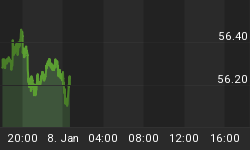With supply fantastically tight in the face of increasing demand and Chinese policy moves that will boost demand further, palladium—the essential auto-catalyst metal—is now doing better than gold.
On Thursday, palladium hit a milestone, crossing over the $1,400 mark for the first time in history and registering a 10-percent-plus gain since the beginning of the New Year.
Spot prices are now at $1,389.8, and the upside is looking great …

(Click to enlarge)
Since mid-August, in fact, palladium prices have gained an astonishing 60 percent. It is now the most expensive precious metal in the world. And the higher this market goes, the more buying is being triggered.
“It is a good old-fashioned squeeze driven by tight fundamentals, strong momentum and low liquidity,” Reuters quoted Saxo Bank analyst Ole Hansen as saying.
And no one’s willing to sell …
“We are seeing steady buying in modest amounts; just no supply and no one willing to sell because you don’t know where it will stop,” CNBC quoted Tai Wong, head of base and precious metals derivatives trading at BMO, as saying.
That’s not the case for gold, which had a slight reprieve as a safe-haven comeback when equities saw a serious stumble in Q4, but as of today, spot gold prices were down 0.7 percent to $1,282.92 per ounce, while U.S. gold futures were down 0.8 percent to $1,282.20 per ounce. Related: How Advertisers Are Forced Into Politics
The biggest driver of demand is, and will be, China. That’s because one of the biggest uses of palladium is as an emissions-reducing catalyst for the auto industry; more specifically, it’s used in pollution-control devices. And China’s got a smog problem that it’s ambitiously attacking to the point that palladium is now the definitive kind of the precious metals space.
But it’s a global phenomenon, really, and demand has soared thanks to the world’s shift from diesel to gasoline and hybrids, with palladium used in catalytic converters for vehicles that run on gasoline.
It also means that global production isn’t keeping up with demand, with production largely concentrated in Russia and South Africa, which together produce around 75 percent of global supply.
“This is the eighth consecutive year where palladium is going to be in deficit and there are no signs that it is going to go away,” Dominic Schnider, head of commodities and APAC forex at UBS Wealth Management in Hong Kong, told CNBC.
According to Zacks, A Citigroup analyst believes the palladium shortage will probably persist through 2020, leading to the “tightest” market in two decades.
Related: This Gold Deal Could Be A Boon For The Mining Industry
“The question people need to ask here is how long it would take for the car manufacturers to switch to platinum, which is trading around $800,” Schnider said.
The only thing that could chip away at that demand is if palladium becomes too expensive and ends up being replaced by platinum. But this is a back-and-forth game because the reverse situation has helped push palladium to its current peak. But it wouldn’t be an easy switch.
“We are told by the makers and buyers of [automotive catalytic converters] that it would take a $500 spread in platinum and palladium for at least two years to have the beginnings of switching,” Market Watch quoted R. Michael Jones, chief executive of Platinum Group Metals, as saying.
By Fred Dunkley for Safehaven.com
More Top Reads From Safehaven.com

















